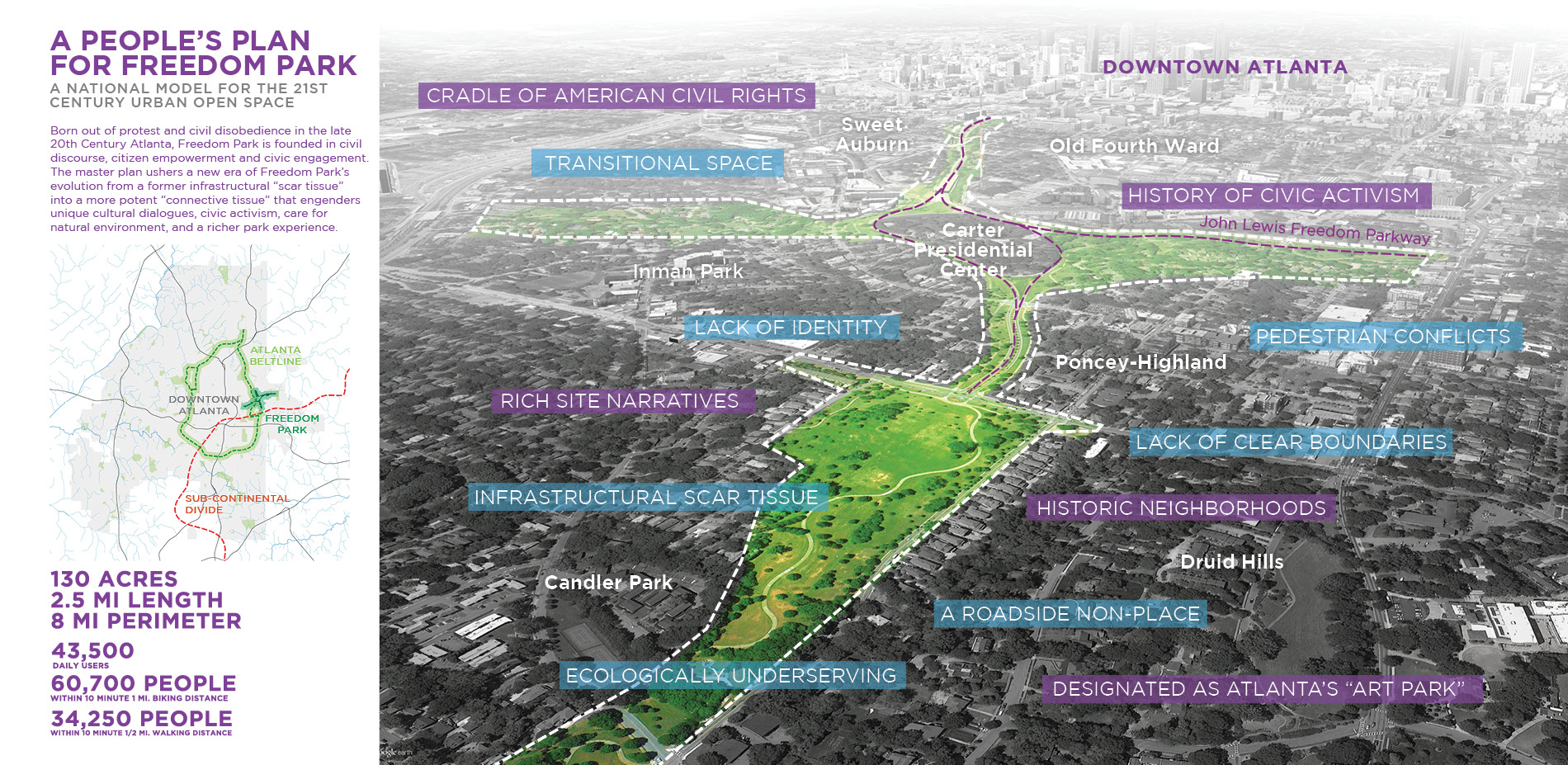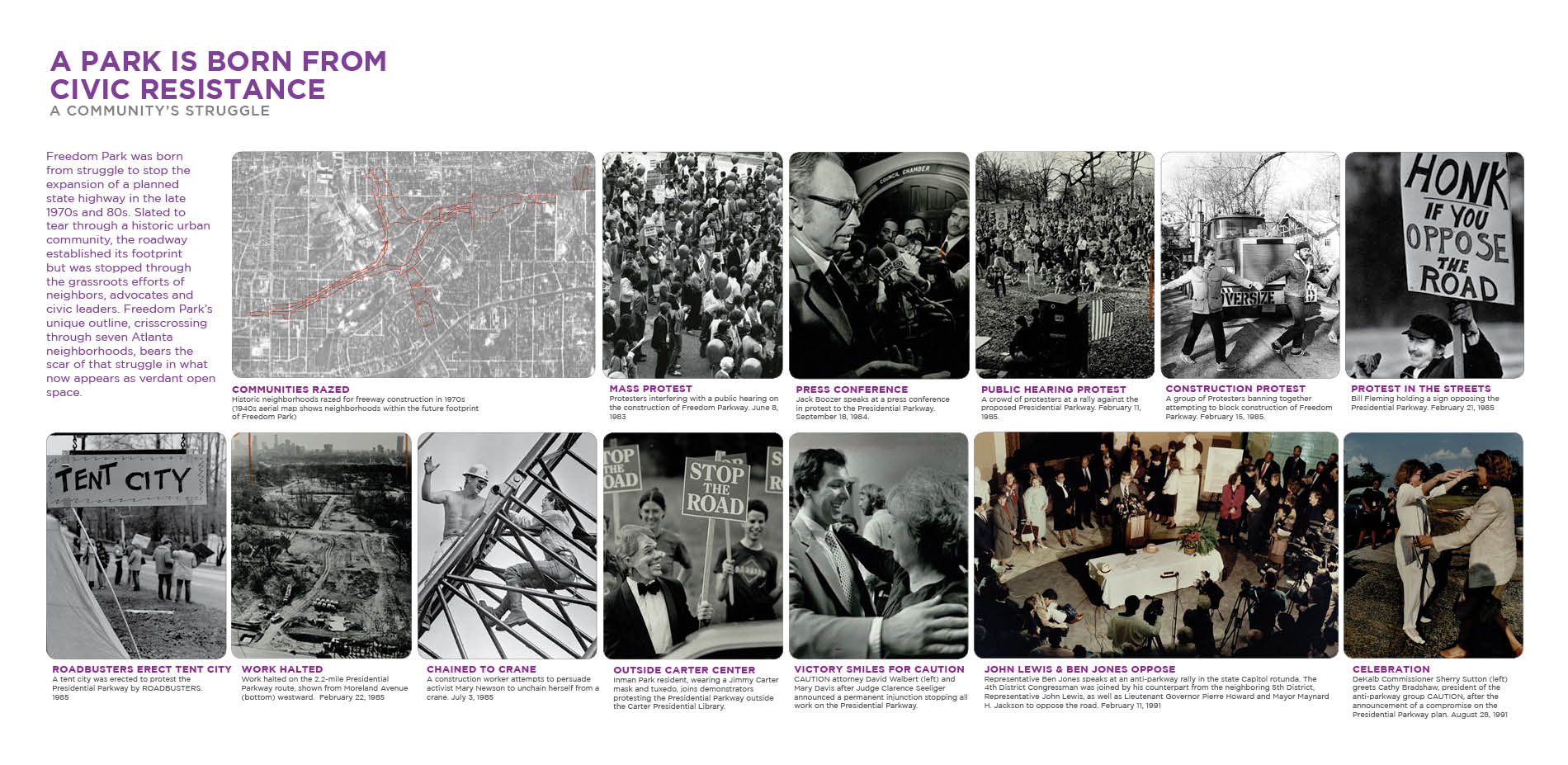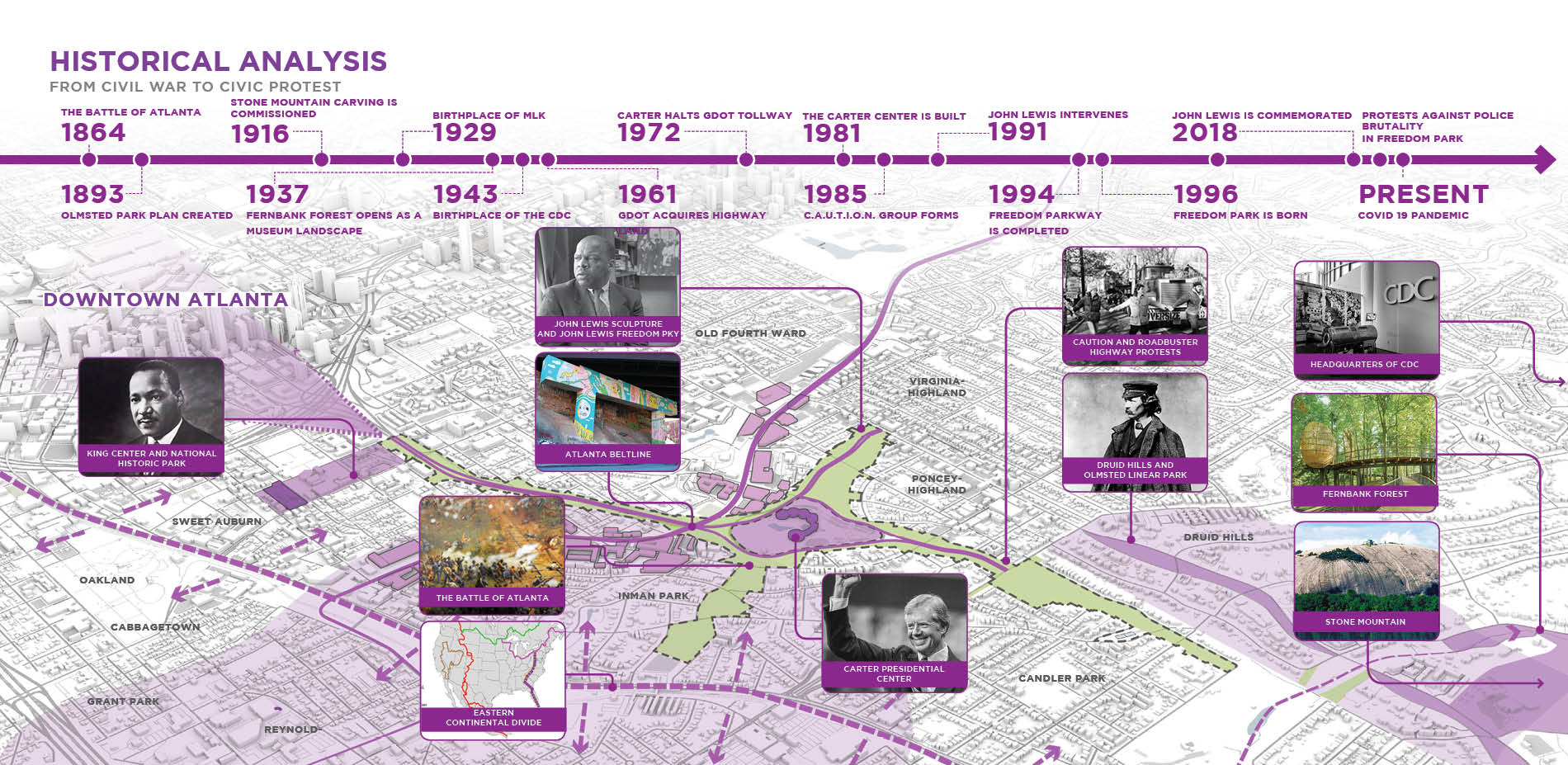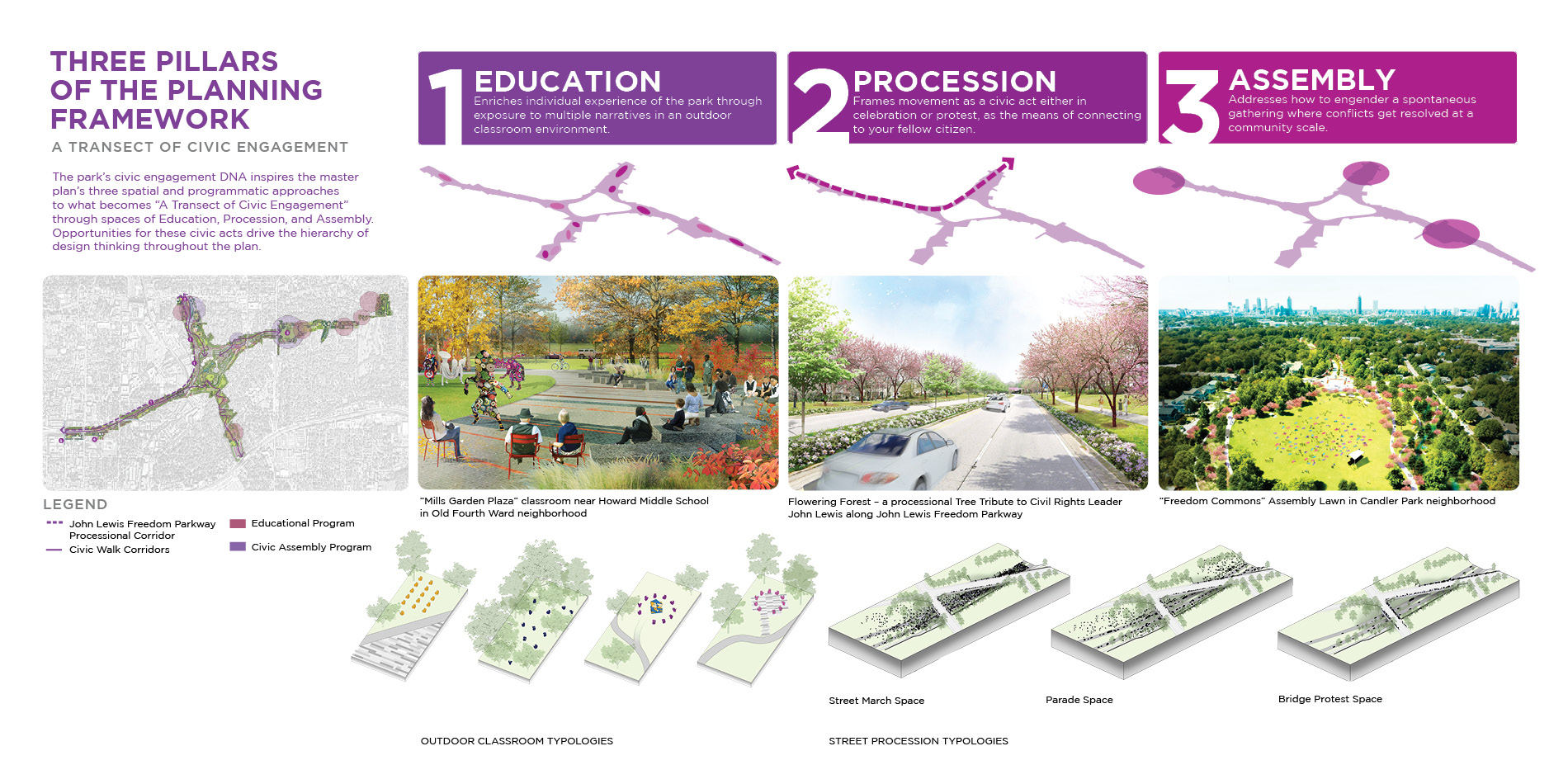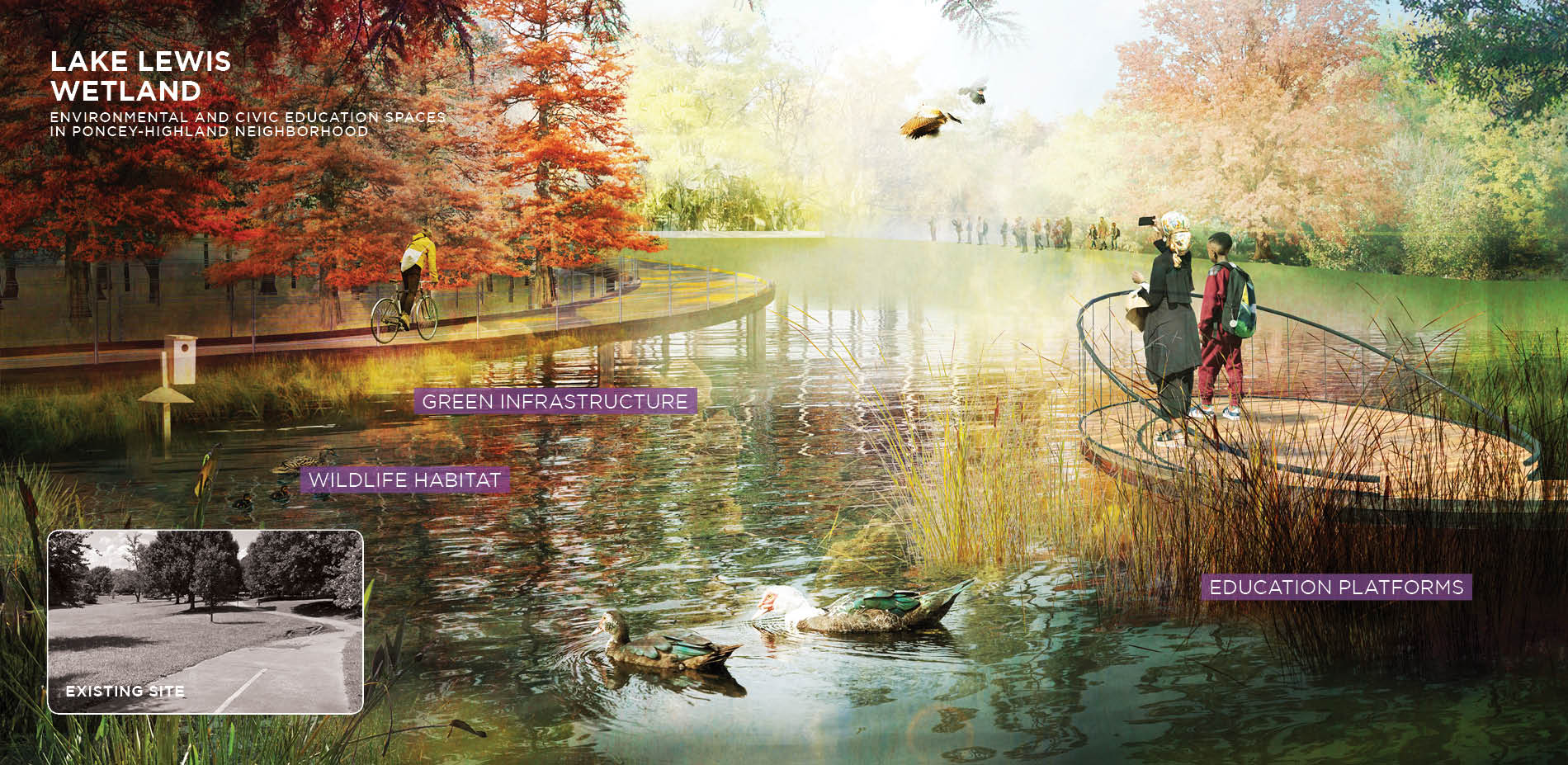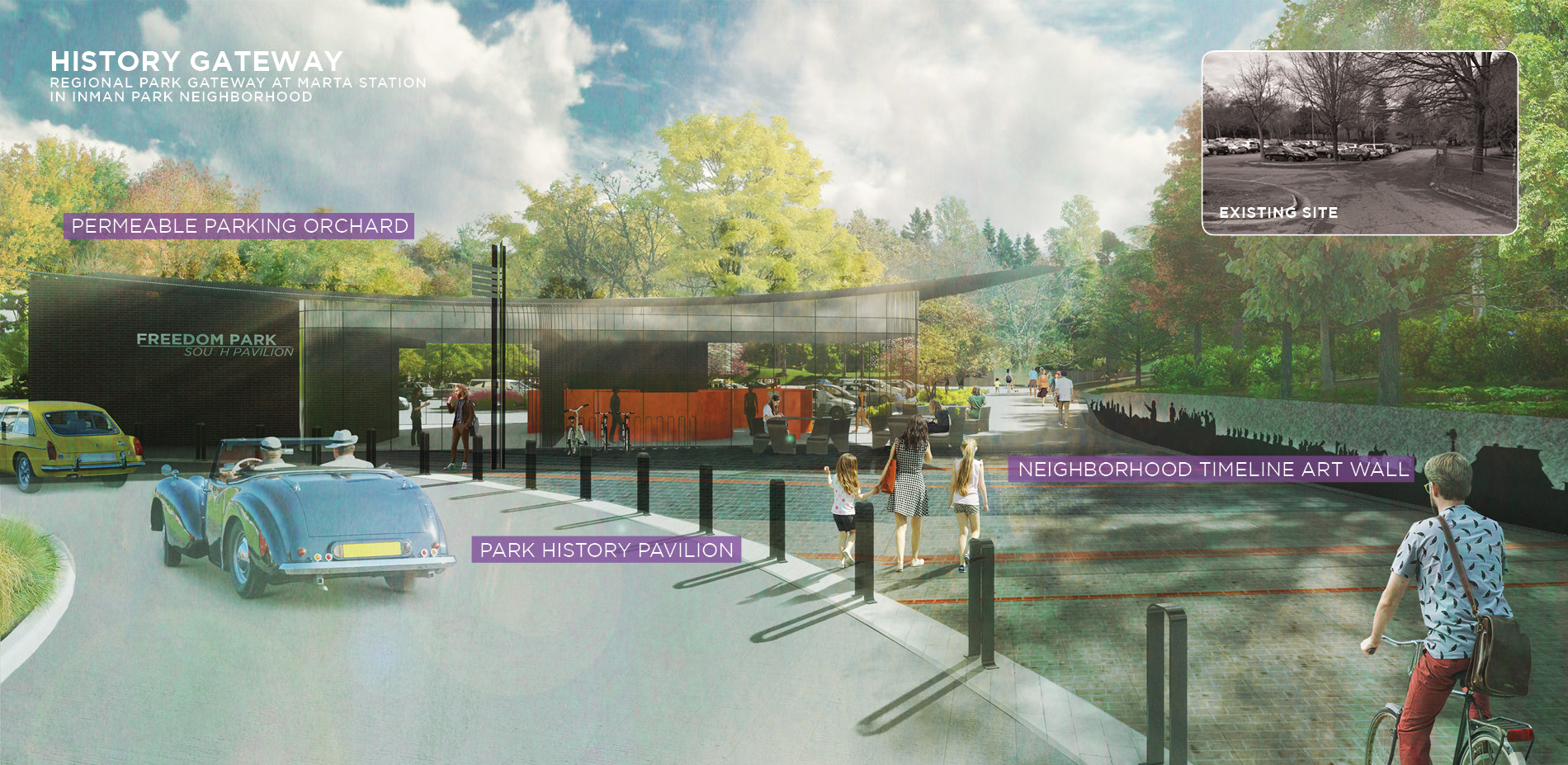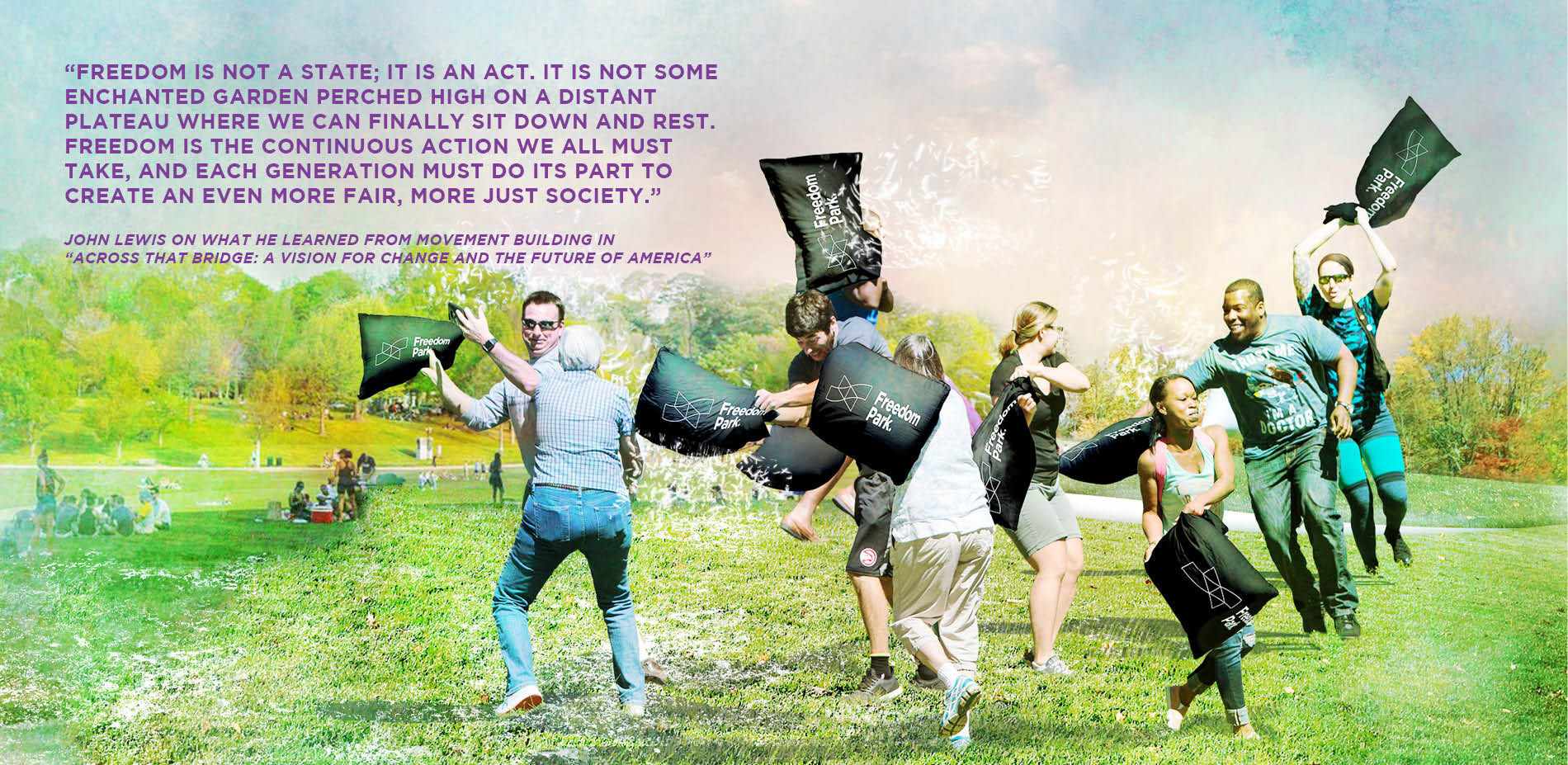A People's Plan for Freedom Park
Honor Award
Analysis and Planning
Atlanta, Georgia, United States
SWA Group
Client: Freedom Park Conservancy
More than 30 years after Atlanta’s Freedom Park emerged from successful grassroots efforts to block a highway expansion, the need for a new vision for the park’s future has arisen. Seeking to unify constituent desires around economic viability alongside ecological value, some 70 potential initiatives were identified and prioritized according to ease of implementation, duration, and cost. Told in a compelling narrative, the People’s Plan exemplifies the imperative goals we need to achieve if we are truly to move forward as socially equitable communities.
- 2021 Awards Jury
Project Credits
Sycamore Consulting, Inc, Public Engagement
Nana Last, Ph.D., Art Strategy and Research
Project Statement
Born from protest and civil disobedience, Freedom Park is founded in civic discourse, citizen empowerment, community engagement, and the responsibilities of ‘freedom’ to a local, national and international audience. Since its founding almost 30 years ago, however, the park’s neighborhoods and global context have evolved. New expectations from diverse, multigenerational constituencies have brought about increased scrutiny to the criteria that defines its successful performance as a park. The master plan ushers in a new era of Freedom Park’s evolution from a former infrastructural “scar tissue” filled with lawns, trees and trails, into a more potent “connective tissue” that engenders unique cultural dialogues, civic activism, environmental stewardship and simply a richer park experience. The plan leverages the park’s unique history, context and association with some of the nation’s great leaders in social justice and welfare by re-defining traditional master planning narratives and focusing on the prioritization of civic discourse. Through this lens, the park utilizes a framework guided by the principals of Education, Procession and Assembly – reinforcing the common ground that defines Atlanta’s Freedom Park.
Project Narrative
Origins of the Park
Freedom Park was born out of a struggle to stop the expansion of a planned state highway in the late 1970s and 80s. Slated to tear through a historic urban community, the roadway established its footprint but was stopped through the grassroots efforts of neighbors, advocates and civic leaders. Freedom Park’s unique outline, crisscrossing through seven Atlanta neighborhoods, bears the scar of that struggle in what now appears as verdant urban open space. The resulting open space, still divided by local parkways, established a park, 130-acres in size and stretching over 2.5 miles in length, with a perimeter that extends over 8 miles in the heart of Eastside Atlanta. In the spring of 2020, the Freedom Park Conservancy, founded in the early 1990’s, began a masterplan process to help define the future development of Freedom Park with the goal of establishing a long-range roadmap. The vision for this master plan seeks to realize the full potential of Freedom Park as an inclusive, connected and distinct open space, championed by its community, and celebrated as one of the best “all things Atlanta”.
Narrative for a 21st Century Park
The narrative behind the establishment of Freedom Park bears form in its unique geographic footprint, tracing its struggle and impact through a diverse assemblage of neighborhoods. Beneath its surface, however, Freedom Park contains stories that extend beyond the struggle of a local community, offering a history of both national and international relevance.
The narratives touched on by Freedom Park are laid out along a transect that extends geographically from the birthplace of Martin Luther King Jr. to the foothills of Stone Mountain. Its connection to national leaders, historic events, demonstrations of civic action and cultural iconography form an urban palimpsest unique to the land on which it sits. The park lies immediately adjacent to the Eastern Continental Divide upon which Atlanta’s first railroads were built, helping to form the economic foundation on which Atlanta grew as a city. The park is the site of the Civil War’s “Battle of Atlanta” where Union and Confederate lines faced off along what is now the southern wing of Freedom Park. The Park adjoins the historic Druid Hills neighborhood, whose bucolic Linear Parks were the last commission of Frederick Law Olmsted before his death in 1903, and of Fernbank Forest, one of the country’s largest and most significant urban old-growth forests.
Freedom Park lies adjacent to the home of the Centers for Disease Control, where national-level research, policy and communication are conducted to protect against ongoing public health threats. At its far western corner, a direct connection to the The King Center and the birthplace of Dr. Martin Luther King Jr. leads one just south of the park into the Sweet Auburn neighborhood. At the heart of Freedom Park, the Carter Presidential Center serves not only as a presidential library, but also as a headquarters to the organization whose mission of advocacy for international health, democracy, and human rights continues today. The road that connects the homes of both Nobel Peace Prize winners is named after congressman John Lewis, a man who galvanized the Civil Rights movement and without whom Freedom Park would be but another urban highway interchange.
Establishing a Cohesive Vision
The Freedom Park Master Plan addresses both fundamental design issues and uncovers the untapped potential of the park. It addresses public safety, legibility and connectivity, while elevating the experience of park users and celebrating its diverse cultural offerings. Most importantly though, the Master Plan seeks to highlight and protect existing park assets while reflecting the insights and aspirations of the local community.
The park systems of Planning, Mobility, Ecology, Program, and Identity were used as organizing pillars for developing ideas and focusing community conversation around the priorities that could be addressed within these systems. The master plan first addressed limitations foundational to its operations as an urban park: pedestrian conflicts presented by an expansive road network, lack of bio-diversity within its landscape, and limited program. The lack of a singular, cohesive identity was then addressed based on a collection of unique stories and assets that are currently hidden from view.
A People’s Plan for Freedom Park
As all initiatives launched in 2020, the pandemic-related restrictions greatly impacted public engagement and outreach. The majority of stakeholder and all of public engagement was conducted on-line via social media platforms, a specially developed website with “Social Pinpoint” interactive tools, as well as videoconferencing, presentations, and both real-time and web-based polling. To a great extent, the sophistication of virtual outreach tools was beneficial to the master planning team’s engagement framework’s flexibility. Through this format the community’s ability to contribute information in the interactive format became a driver for the plan’s components, establishing a continual feedback loop throughout the master planning process. The virtual engagement’s public forum was also augmented with numerous one-on-one stakeholder conversations that targeted multiple topical elements in the plan in order to leverage the existing interest, momentum, and goals of these vested entities. Likewise, local neighborhood groups each submitted white papers outlining key concerns, priorities and insights that helped to give form to project priorities.
Master Plan Goals
The framework for the master plan is established on the principles of three guiding themes, each reflective of the legacy of the park’s unique cultural history. Identified initiatives and development projects focused on the principles of civic engagement through Assembly, Education and Procession.
Based on this framework, seven overarching park goals for the master plan were established. The hierarchy of each goal acknowledges the park’s important service as a local amenity, a regional resource, as well as a place of national relevance and international significance. Based on public dialogue that took place during the master planning process, a community ranking exercise helped formalize prioritization of these goals, giving focus to master plan development prioritization.
Seven Project Goals:
1. Enhance Ecological Value of the Park
2. Complete the park as alternative Regional Mobility Infrastructure
3. Position the Park as Unique International Art Space
4. Support Adjacent Neighborhood Vitality
5. Highlight Local, National and International Civic Role of the Park
6. Elevate National Significance of the park as Signature Atlanta Open Space
7. Increase Economic Viability of the Park
Projects Prioritization
Based on these seven goals for the Master Plan, over 70 project initiatives were identified, forming the overall vision for the project. In order to prioritize future funding and feasibility efforts associated with these projects, a series of five Prioritization Criteria were developed, with which each project was evaluated:
1. Catalytic Projects (projects provide immediate improvements while elevating the park profile in alignment with the goals of the master plan)
2. Opportunistic (Projects that take advantage of existing partnerships or have a high value-to-cost ratio)
3. Contributing to Public Safety (projects that provide benefit through improvements that address the safety, security and well-being of park users)
4. Big Ideas that Require Further Study (projects that require significant Public Agency coordination and feasibility assessment)
5. Public Priority (projects prioritized based on public survey response)
Based on evaluation of these criteria, seven Signature Projects were identified that move Freedom Park towards achieving the seven goals identified within the master plan. In order to assist in developing interest and coordinate design efforts of interrelated projects, each Signature Project consists of a series of aligned projects that are to be studied, planned, fundraised for and potentially implemented as a singular effort.
Collectively, these projects touch on themes relating to recognition of the legacy of national heroes, environmental stewardship, places for civic engagement, prioritizing pedestrian experiences, expanding mobility opportunities, cultural expression and neighborhood vitality. Taken together, they re-position Freedom Park as an equitable, culturally rich and civic-minded urban park within the City of Atlanta; a national example for the importance of citizen empowerment and the value of common ground.
